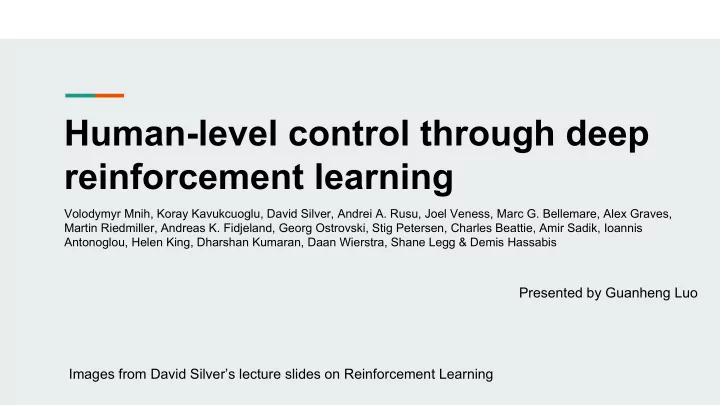

Human-level control through deep reinforcement learning Volodymyr Mnih, Koray Kavukcuoglu, David Silver, Andrei A. Rusu, Joel Veness, Marc G. Bellemare, Alex Graves, Martin Riedmiller, Andreas K. Fidjeland, Georg Ostrovski, Stig Petersen, Charles Beattie, Amir Sadik, Ioannis Antonoglou, Helen King, Dharshan Kumaran, Daan Wierstra, Shane Legg & Demis Hassabis Presented by Guanheng Luo Images from David Silver’s lecture slides on Reinforcement Learning
Overview Combine reinforcement learning with deep neural networks ● Traditional reinforcement learning is limited to low ○ dimensional input Deep neural network can extract abstract representation ○ from high dimensional input Overcome the convergence issue using the following techniques ● Experience replay ○ Fixed Q target ○
What is deep reinforcement learning
What is deep reinforcement learning observation action Goal: To train an agent that interacts (performs actions ) with the environment given the observation such that it will receive the maximum reward accumulated reward at the end.
Settings: At each step t, The agent: Receives observation o t ● Receives scalar reward r t ● Executes action a t ● The environment: Receives action a t ● Emits observation o t+1 ● Emits scalar reward r t+1 ●
Settings: At each step t, The agent: Receives observation o t ● Receives scalar reward r t ● Executes action a t ● The environment: Receives action a t ● Emits observation o t+1 ● Emits scalar reward r t+1 ●
Settings: At each step t, The agent: Receives observation o t ● Receives scalar reward r t ● Executes action a t ● The environment: Receives action a t ● Emits observation o t+1 ● Emits scalar reward r t+1 ●
Settings: At each step t, The agent: Receives observation o t ● Receives scalar reward r t ● Executes action a t ● The environment: Receives action a t ● Emits observation o t+1 ● Emits scalar reward r t+1 ●
Settings: At each step t, +1 The agent: Receives observation o t ● Receives scalar reward r t ● Executes action a t +1 ● The environment: Receives action a t ● Emits observation o t+1 ● Emits scalar reward r t+1 ●
Settings: At each step t, The agent: Receives observation o t ● Receives scalar reward r t ● Executes action a t ● The environment: Receives action a t ● Emits observation o t+1 ● Emits scalar reward r t+1 ●
What is deep reinforcement learning “ Experience” is a sequence of observation, rewards ● and actions “State” is a summary of the experience ● (actual input to the agent)
What is deep reinforcement learning An agent can have one or more of the following components: Policy ● What should I do? Determine agent’s behavior ○ (can be derived from value function) ○ Value Function ● Am I in a good state? How good for the agent to be in a state ○ (What is the accumulated reward after this state) ○ Model ● The representation of the environment in the agent’s perspective ○ (usually used for planning) ○
What is deep reinforcement learning Value Function (Q-value function): Expected accumulated reward from state s and action a ● is the policy ● is the discount factor ●
What is deep reinforcement learning Value Function (Q-value function): Expected accumulated reward from state s and action a ● ● s’ is the state arrived after performing a and a’ is the action picked at s’
What is deep reinforcement learning Optimal Value Function (oracle): Optimal Policy:
S What is Q*(S, down)? What is Q*(S, right)? Q*(S, down) = -1000 Q*(S, right) = 1000 = right
What is deep reinforcement learning To obtain Optimal Value Function: Update our value function iteratively target prediction loss
What is deep reinforcement learning To obtain Optimal Value Function: Update our value function iteratively target prediction loss
What is deep reinforcement learning Issues: Can’t derive efficient representations of the environment ● from high-dimensional sensory inputs Atari 2600: 210 x 160 pixel images with a 128-colour palette ○ Can’t generalize past experience to new situations ●
What is deep reinforcement learning Solutions: Approximate the value function with linear function ● Require well-handcrafted feature ○ Approximate the value function with non-linear function ● End to end ○
What is deep reinforcement learning Approximating the value function with deep neural network, i.e. DQN (Deep Q-Network)
Detail Network Structure Input: 84 * 84 * 4 image First: 32 filters, 8 * 8, stride 4 Second: 64 filters, 4 * 4, stride 2 Third: 64 filters, 3 * 3, stride 1 Last: 512 rectifier units Output: Q-value of 18 actions
In deep reinforcement learning target prediction loss
In deep reinforcement learning target prediction loss Let be the weight of the network at iteration i. Then: Target y = prediction
Detail The loss of the network at i-th iteration (mean-squared error)
Detail Then it is just performing gradient descent on
However, Reinforcement learning using non-linear function may not converge, due to: The correlations present in the sequence of observations, ● the fact that small updates to Q may significantly change the policy and therefore change the data distribution Solution: experience replay ○ The correlations between the action-values ● and the target values Solution: fixed Q targets ○
Detail One game Take a step Experience replay Fix Q target
In deep reinforcement learning target prediction loss
Detail
Result 100 * (DQN score - random play score)/ (human score - random play score)
Parameters
https://media.nature.com/original/nature-assets/nature/journal/v518/n7540/extref/nature14236-sv2. mov
Thanks for watching
t-SNE embedding
Recommend
More recommend